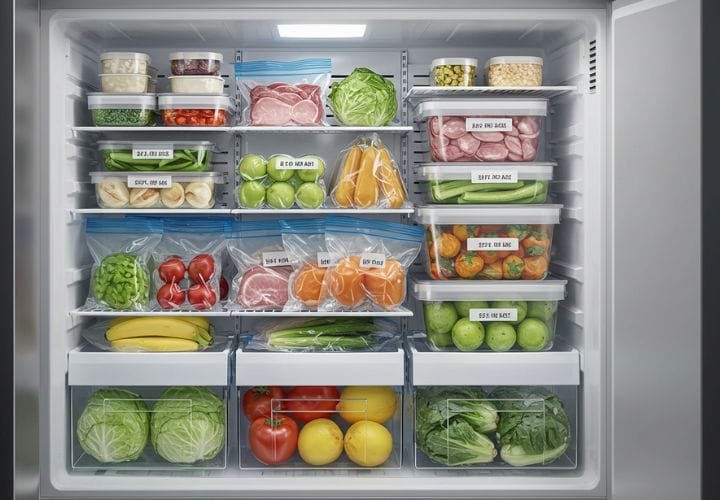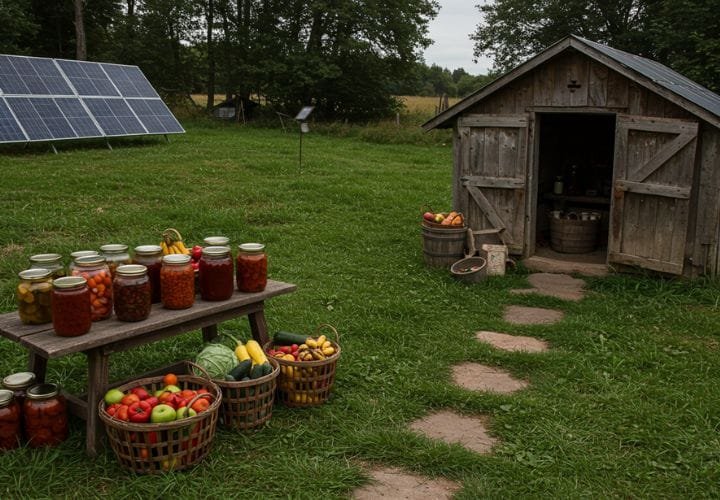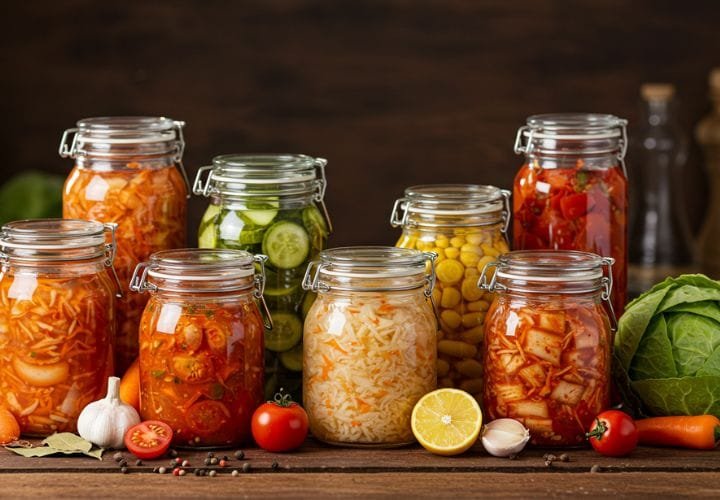Ever wondered how people long ago kept food fresh without fridges? They relied on age-old secrets of food preservation that remain practical and effective today. These methods are not just about preventing spoilage—they’re essential for saving food, reducing waste, and living more sustainably.
Revisiting these traditional techniques can help us in modern times. Whether you’re looking to save money, make fewer trips to the store, or enjoy seasonal foods all year round, these practices offer valuable solutions.
Learning the art of food preservation opens up a world of possibilities. It allows you to store healthy, fresh food for months—or even years—while boosting self-sufficiency. Plus, it gives you control over what goes into your food. Let’s take this journey together, reconnecting with the wisdom of our ancestors and embracing a more sustainable future.
Introduction to Food Preservation
Have you ever wondered how to keep food fresh and safe for longer,especially when living off-grid? Food preservation is not just about extending shelf life; it’s a powerful way to reduce waste, maintain nutrition, and ensure a reliable food supply. In this section, we’ll dive into the importance of preserving food and explore time-tested and modern techniques for keeping it fresh.
The Importance of Food Preservation
Preserving food goes beyond convenience—it’s a lifeline for self-sufficiency and sustainability, particularly in off-grid settings. By preventing spoilage, you reduce waste and maximize the nutritional value of your food.
Canning is a favorite for long-term storage. This method sterilizes food to stop spoilage, making it ideal for homesteaders and anyone seeking reliable preservation. To stay organized, always label your jars with dates and contents. Use the “first in, first out” system and store them in a cool, dark pantry to extend their freshness.
- Blanching vegetables before freezing locks in their color, flavor, and nutrients. This simple step ensures frozen foods maintain their quality.
- Keeping a food inventory list helps manage your stock efficiently and prevents over-preserving or forgetting items in storage.
- Choosing the right storage space, whether it’s a root cellar, pantry, or freezer, is crucial for maintaining food quality.
Historical Context and Evolution
The ways to preserve food have evolved significantly over the centuries. Traditional methods like drying, salting, and fermenting laid the groundwork for survival in harsh climates and long winters without fresh food. These techniques, though ancient, remain valuable and have been refined to suit modern needs.

The advent of canning in the 19th century revolutionized food preservation. With the development of methods like water bath canning and pressure canning, it became possible to safely store a wider variety of foods. This innovation not only extended the shelf life of perishable items but also paved the way for year-round access to preserved foods. Today, these methods support sustainable living and long-term food storage.
“The art of food preservation is as much about heritage as it is about practicality. Mastering these skills ensures you can thrive in any environment, from urban settings to off-grid living.” – The National Center for Home Food Preservation
Modern food preservation techniques blend the wisdom of traditional methods with advanced technology. Vacuum sealing, freeze-drying, and improved fermentation practices provide even more options for keeping food fresh and reducing waste. By embracing these skills, you can maintain a reliable food supply, minimize waste, and enhance your journey toward self-sufficiency and sustainable living.
Traditional Canning Methods

Canning has been a trusted way to preserve food for generations, letting you enjoy the flavors of your garden all year long. Beyond convenience, home canning ensures better taste, quality, and control over what goes into your food. By mastering this skill, you can preserve your harvest safely and deliciously. This section explores two essential canning methods: water bath canning and pressure canning, along with key safety advice.
Water Bath Canning
Water bath canning is ideal for preserving high-acid foods such as fruits, jams, and pickles. The process involves submerging jars in boiling water for a specific amount of time. The high heat kills bacteria and halts enzymatic activity, ensuring your food remains safe and flavorful. To avoid common mistakes, always follow trusted guidelines and ensure your jars and lids are sterilized before use.
Pressure Canning
For low-acid foods like vegetables, meats, and soups, pressure canning is essential. This method uses a pressure canner to reach temperatures higher than boiling water, effectively eliminating harmful bacteria, including the one that causes botulism. Using proper equipment and sticking to tested recipes is critical for safety. Before starting, always inspect your canner, jars, and seals for any signs of wear or damage.
Safety Tips for Home Canning
Preserving food safely requires attention to detail and proper practices. Here are some essential tips to ensure success:
- Use Reliable Equipment: Invest in high-quality canning tools that are durable and safe to use.
- Follow Tested Recipes: Only use recipes from credible sources to maintain safe pH levels and avoid contamination.
- Check for Proper Seals: After processing, ensure all jars are sealed correctly. Refrigerate and use any jars with broken seals promptly.
- Store Properly: Keep your canned goods in a cool, dark, and dry place to extend their shelf life and maintain freshness
By using the right methods and paying attention to detail, home canning becomes a rewarding way to preserve food all year round. Whether you’re a beginner or an experienced canner, following safety guidelines ensures that your hard work pays off with safe, delicious results every time.
Drying and Dehydrating Food
Drying and dehydrating food helps keep it safe for a long time. This method keeps the food’s good parts while it’s stored. Many people use this method at home because it has many pluses.
Benefits of Dehydrating
Dehydrating food offers countless advantages, especially for those who grow their own fruits and vegetables. This method of food preservation extends shelf life, saves storage space, and reduces food waste. It’s also cost-effective and particularly beneficial for individuals with special dietary needs, allowing them to prepare healthy snacks and meals tailored to their preferences.
Methods of Drying Food
There are many ways to dry out food, each with its own advantages. Here are a few:
- Sun Drying: This traditional method uses the power of the sun and works best in places with lots of sunlight and low humidity.

Food dehydrator with trays of sliced fruits and vegetables, herbs air-drying, and sunlight streaming in. - Air Drying: Perfect for herbs, this method involves hanging them in a spot with plenty of airflow, allowing them to dry naturally.
- Oven Drying: When it’s damp outside, you can use your oven set to a low temperature to dry small amounts of food efficiently.
- Using a Dehydrator: A dehydrator provides consistent heat and airflow, making it the most reliable and efficient choice for drying food.
Dehydrator vs. Sun Drying
Choosing between a dehydrator and sun drying depends on a few things, especially if you’re drying food at home. Sun drying is free since it uses the sun’s power, but it might not work well when it’s humid. A dehydrator gives you control, giving steady results no matter the weather.
| Method | Advantages | Disadvantages |
|---|---|---|
| Sun Drying | Cost-effective, eco-friendly | Weather-dependent, less control over drying process |
| Dehydrator | Consistent results, usable year-round | Initial cost, electricity usage |
Pick a drying method that fits your life and where you live. Dehydrating food keeps it nutritious and is a smart way to store food for a long time.
Freezing Food for Long-Term Storage

Best Practices for Freezing Food
Proper Pre-Treatment and Packaging for Freezing Food
Freezing food effectively requires proper pre-treatment and packaging to maintain quality and prevent spoilage. Here are key steps to ensure your food stays fresh:
- Blanch vegetables before freezing to preserve their color, texture, and nutrients. This step halts enzymatic activity that can degrade food quality over time.
- Use vacuum sealing to remove air from the packaging, extending the shelf life and preventing freezer burn, which occurs when food is exposed to air for too long.
- Utilize airtight, stackable containers to maximize freezer space and keep food fresh. These containers protect against moisture and odors.
- Label packages with their contents and the freezing date. This makes it easier to track what you have and avoid wasting older items.
Common Mistakes to Avoid
Avoid these errors to ensure your frozen food maintains its quality
| Common Mistakes | Solutions |
|---|---|
| Overloading the freezer | Distribute food evenly to ensure air circulation |
| Freezing large quantities at once | Freeze smaller batches for quicker freezing |
| Not cooling food before freezing | Allow food to cool to room temperature first |
| Using improper packaging | Opt for vacuum sealing food to prevent freezer burn |
Follow these tips and avoid the common mistakes to keep your food great for longer. Taking steps like vacuum sealing or freeze drying really helps. It ensures your stored food stays tasty, textured, and nutritious.
Benefits of Producing and Storing Food Off-Grid

Producing and storing food on your own offers many perks. It helps people live a *self-sufficient and sustainable* life. Techniques to preserve food increase how long your produce lasts. This way, you always have food.
Food Independence
Storing your own food gives you the freedom to enjoy fresh produce at its peak while saving money. A recent survey showed that 67% of people preserve food to enjoy it when it’s ripe. By reducing reliance on store-bought food, you gain more control over what you eat and how it’s prepared.
Having your own food supply also allows you to meet specific health needs. This was a key factor for 45% of respondents. Choosing how to preserve food ensures safer and healthier eating, tailored to individual dietary requirements.
Sustainable Practices in Food Preservation
Using eco-friendly methods to prepare and store food reduces environmental harm while promoting sustainability. Although 71% of people noted that cost and setup can be hurdles, investing in durable materials like reusable containers and gamma lids pays off over time. These items save money and significantly reduce waste.
Finding creative storage solutions, such as using under-bed spaces or repurposing old canning lids for pantry goods, is both cost-effective and sustainable. These small actions contribute to a greener lifestyle while keeping food fresh and organized.
Adopting diverse preservation methods, such as freezing (chosen by 76%) or dehydrating (22%), ensures a steady, healthy food supply year-round. These techniques prepare you for seasonal changes and unexpected events, supporting long-term food security.
By incorporating these practices, you not only reduce your environmental impact but also foster greater independence and resilience.
Examples like sauerkraut, kimchi, and yogurt highlight how fermentation combines preservation with enhanced flavor. These foods not only taste better but also contain probiotics, which promote gut health and boost immunity. Lesser-known options like kombucha, tempeh, and miso further showcase the versatility of fermentation across cuisines.
By embracing fermentation techniques, you can enjoy diverse, nutrient-rich foods while significantly reducing food waste. Whether you’re interested in experimenting with new flavors or seeking sustainable food practices, fermentation is a valuable addition to any kitchen.
Fermenting Food for Enhanced Flavor and Preservation

At its core, fermentation is a biological process where microorganisms—like bacteria and yeast—convert sugars into alcohol or acids. This transformation not only preserves food but also improves its digestibility and nutritional value. For instance, low-acid foods are converted into high-acid foods, making them safer to store and more beneficial for health.
The Science Behind Fermentation
At its core, fermentation is a biological process where microorganisms—like bacteria and yeast—convert sugars into alcohol or acids. This transformation not only preserves food but also improves its digestibility and nutritional value. For instance, low-acid foods are converted into high-acid foods, making them safer to store and more beneficial for health.
Popular Fermented Foods
Fermentation can make food taste better and last longer. Some favorites include
sauerkraut, kimchi, pickles, sourdough, cheese, yogurt, kefir, and kombucha. These foods not only taste great but also help your digestion.
Using fermentation enhances flavor and preserves food. Adding these foods to your meals brings health benefits and great taste.
Curing and Smoking Techniques

Curing and smoking meats are time-tested methods of preservation that also enhance flavor. These techniques not only keep food from spoiling but also transform it into gourmet-quality products. From salty, savory cured hams to smoky, flavorful sausages, these methods enrich your pantry with long-lasting, delicious options.
Basics of Curing Meats
Curing involves using salt, sugar, and sometimes other seasonings to draw moisture out of the meat, inhibiting bacterial growth. There are two main methods:
- Dry Curing:
This method involves rubbing salt directly onto the surface of the meat. The salt extracts moisture and infuses flavor. Dry curing is commonly used for prosciutto, bacon, and beef jerky. - Brining:
In this method, the meat is soaked in a saltwater solution, often with added herbs and spices for flavor. Brining is ideal for poultry, pork chops, and fish, adding both moisture and flavor to the final product.
These curing techniques not only preserve the meat but also create complex and savory flavors that elevate any dish. Whether you’re preparing a classic cured ham or experimenting with homemade bacon, curing is a rewarding practice for anyone who enjoys DIY food preparation.
Smoking for Flavor and Preservation
Smoking food is an ancient method that combines flavor enhancement with preservation. By exposing food to smoke, this technique not only infuses it with a unique, rich taste but also creates a protective barrier against bacteria and spoilage.
There are two main types of smoking, each with specific temperatures and purposes:
- Cold Smoking: This method uses smoke at low temperatures (below 100°F) to infuse flavor into the food without cooking it. It’s ideal for delicate items like cheese, fish, and nuts, where maintaining texture is key.
- Hot Smoking: In this method, food is both cooked and flavored by smoke at temperatures ranging from 165°F to 250°F. This is perfect for meats like ribs, chicken, and sausages, as the heat ensures the food is safe to eat while adding a smoky depth of flavor.
| Methods | Temperatures | Primary Purpose |
|---|---|---|
| Cold Smoking | Below 100°F | Flavor infusion |
| Hot Smoking | 165°F – 250°F | Cooking and flavoring |
Using these smoking methods makes your food last longer and taste better. Knowing how to cure and smoke meats means your food will be both yummy and safe to keep for a long time.
Conclusion
As we conclude our exploration of food production, preservation, and storage, it’s clear how vital these skills are for building a sustainable lifestyle. Techniques like canning, drying, freeze-drying, and fermentation each offer unique advantages, catering to various kitchen needs and preferences. Mastering these methods helps ensure a steady and reliable food supply for your home.
Efforts to reduce food waste not only benefit the planet but also promote your self-sufficiency. Simple practices, such as using five-gallon buckets with gamma seal lids for bulk storage or setting up a root cellar, allow you to keep food fresh across seasons and during emergencies. These solutions are cost-effective and environmentally friendly, making them ideal for long-term food security.
Additionally, buying in bulk and preserving food correctly can lead to significant savings while providing peace of mind. Well-stored food means fewer trips to the store, more nutritious meals, and preparedness for any situation. Imagine the freedom and stability of knowing your pantry is stocked with healthy, home-preserved food for your family.
Every small step you take toward food independence—whether it’s learning to ferment vegetables or organizing a storage system—has a big impact. These efforts not only enhance your family’s well-being but also contribute to a healthier planet. Start today, and see how these simple changes can lead to a more sustainable, resilient, and rewarding lifestyle.
FAQ
What are the most common food preservation methods?
Canning, dehydrating, freezing, fermenting, curing, and smoking are key methods. Each one has unique benefits and uses. They make it easier to keep food longer depending on what you have.
Why is food preservation important?
It’s key for keeping food safe and fresh longer. It helps in reducing waste. By preserving food, we ensure it stays nutritious and safe to eat.
What are the differences between water bath canning and pressure canning?
Water bath canning works well for acidic foods like fruits and jams. It uses boiling water to preserve them. Pressure canning is meant for low-acid foods such as meats. It uses high-pressure steam to kill harmful bacteria.
How does dehydration preserve food?
By removing moisture, dehydration stops microorganisms from spoiling food. This method keeps the food’s nutrition but extends its storage life greatly.
What are the best practices for freezing food?
Before freezing, blanch vegetables. Use containers or vacuum-sealed bags to avoid freezer burn. Label them with dates. This keeps the food’s quality and texture.
How does off-grid food production contribute to sustainability?
It lessens dependence on outside sources and cuts the environmental footprint. Off-grid methods help in achieving food independence without waste.
What are some popular fermented foods and their benefits?
Foods like sauerkraut, kimchi, and kombucha are popular. Fermentation boosts flavor and preservation. It also supports gut health with probiotics.
What are the basics of curing meats?
Using salt, nitrates, or sugar, curing draws out moisture from meat. It stops microbes from growing and flavors the meat. This method is key for long-term meat storage.
How can smoking food enhance flavor and preservation?
Smoking adds a smoky flavor and acts as a preservative by lowering moisture. It’s great for meats, fish, and cheeses.
What are some common mistakes to avoid when preserving food?
Avoid not sealing jars right when canning, skipping vegetable pre-treatments before freezing, and not drying food enough when dehydrating. Paying attention and following steps ensures preservation is done right.
Source Links:


